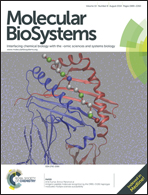The efficiency of compounds with α-amino-β-mercapto-ethane group in protection of human serum albumin carbonylation and cross-linking with methylglyoxal
Abstract
α-Oxoaldehydes, which are produced in higher quantities in diabetes, uremia, oxidative stress, inflammation and aging, react with the amino, guanidine and thiol groups of proteins and cause the formation of advanced glycated end-products and protein cross-linking. To prevent these reactions, the efficiency of low molecular mass thiols with an α-amino-β-mercapto-ethane group (Cys, penicillamine and N-acetylcysteine (NAcCys, with a blocked amino group)) as scavengers of methylglyoxal, compared with glutathione (GSH) and the biguanidine derivative metformin, was investigated. The time courses of the reactions of the aforementioned compounds with methylglyoxal were assayed. The reactivity of their thiol and amino groups decreased in the order of Cys > penicillamine > GSH > NAcCys and penicillamine > Cys > GSH, respectively. Human serum albumin (HSA) carbonylation in the absence or presence of methylglyoxal scavengers were monitored by the determination of the amino, guanidine and thiol groups' contents, as well as by spectrofluorimetry, CD and native and SDS PAGE. Cys and penicillamine were highly efficient in the prevention of the carbonylation of the HSA-amino (for 80%) and guanidine (for 84% and 55%, respectively) groups and the formation of fluorescent AGEs. GSH and metformin exhibited medium efficiency (reduction of amino group's carbonylation for 60% and guanidine for about 30%); the least efficient was NAcCys. The presence of Cys, penicillamine and NAcCys led to an almost complete protection of the HSA-thiol group's carbonylation, whereas metformin was inefficient. The efficiency in the prevention of protein cross-linking increased in the order of metformin, NAcCys < GSH < penicillamine < Cys. Thus, the substances with an α-amino-β-mercapto-ethane group as a pharmacophore exhibit great potential as an efficient methylglyoxal scavengers, and are thus promising compounds for medicinal chemistry. In addition, they protect the HSA-SH group and preserve its antioxidative potential, which is very important for the HSA's function in vivo.


 Please wait while we load your content...
Please wait while we load your content...